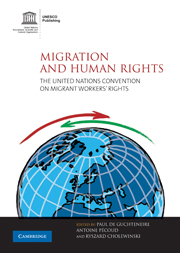Book contents
- Frontmatter
- Contents
- List of figures
- List of tables
- Notes on contributors
- Abbreviations
- 1 Introduction: The UN Convention on Migrant Workers' Rights
- PART I
- 2 Migration and human rights: the uneasy but essential relationship
- 3 Role of civil society in campaigning for and using the ICRMW
- 4 Committee on Migrant Workers and implementation of the ICRMW
- 5 Migrants' rights in UN human rights conventions
- 6 The need for a rights-based approach to migration in the age of globalization
- PART II
- Annex 1 International Convention on the Protection of the Rights of All Migrant Workers and Members of Their Families Adopted by General Assembly Resolution 45/158 of 18 December 1990
- Annex 2 Ratifications of ILO Conventions 97 and 143 and of ICRMW as at June 2009
- Index
- References
2 - Migration and human rights: the uneasy but essential relationship
Published online by Cambridge University Press: 02 December 2010
- Frontmatter
- Contents
- List of figures
- List of tables
- Notes on contributors
- Abbreviations
- 1 Introduction: The UN Convention on Migrant Workers' Rights
- PART I
- 2 Migration and human rights: the uneasy but essential relationship
- 3 Role of civil society in campaigning for and using the ICRMW
- 4 Committee on Migrant Workers and implementation of the ICRMW
- 5 Migrants' rights in UN human rights conventions
- 6 The need for a rights-based approach to migration in the age of globalization
- PART II
- Annex 1 International Convention on the Protection of the Rights of All Migrant Workers and Members of Their Families Adopted by General Assembly Resolution 45/158 of 18 December 1990
- Annex 2 Ratifications of ILO Conventions 97 and 143 and of ICRMW as at June 2009
- Index
- References
Summary
Introduction
The ICRMW, one of the seven human rights instruments of the international community, has some notable peculiarities. It is the longest of the UN instruments, it had the slowest progress between adoption and entry into force and it has the smallest number of participating countries (Battistella, 2004). This is no coincidence but is inherently linked to the difficulty the international community has in approaching migration from a human rights perspective and agreeing on standards for its management. To illustrate this position, this chapter retraces the history of the development of international migration standards for migrants before the Convention and then focuses on its preparation, drafting and ratification stages. The various stages show, on the one hand, the close connection between human rights development and protection to migrants, and on the other hand the reluctance to extend agreed principles to migrants as this militates against the flexibility of migration, which no country is willing to renounce. A brief overview of prospects for additional ratifications is also given. After summarizing some reasons for the limited expectations of the role of the Convention, signs of hope for the protection of migrants are indicated.
Human rights and migrants before the ICRMW
Concern for the protection of migrants had been growing for some years before the international community started thinking of an international convention. However, this process was rather slow and limited in the areas involved and the categories of migrants considered.
- Type
- Chapter
- Information
- Migration and Human RightsThe United Nations Convention on Migrant Workers' Rights, pp. 47 - 69Publisher: Cambridge University PressPrint publication year: 2009
References
- 10
- Cited by

